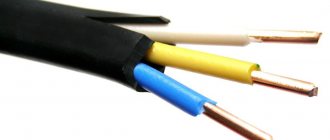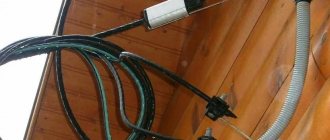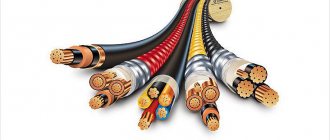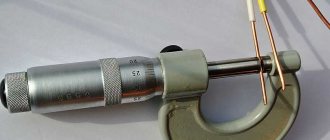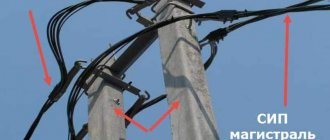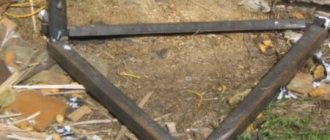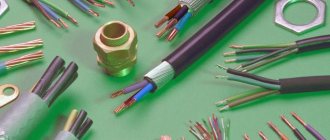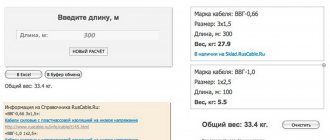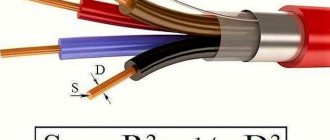In electrical networks there are many parameters determined in various ways. Among them there is a special table; the diameter and cross-section of the wire are determined with high accuracy using it. Such precise data is required when adding an electrical load, and the old wire does not have letter markings. However, even conventional designations do not always correspond to reality. This is mainly due to the dishonesty of product manufacturers. Therefore, it is best to do your own calculations.
Application of measuring instruments
To determine the diameter of the cores of wires and cables, various measuring instruments are widely used, showing the most accurate results. Basically, the use of micrometers and calipers is practiced for these purposes. Despite their high efficiency, a significant drawback of these devices is their high cost, which is of great importance if the tool is planned to be used only 1-2 times.
As a rule, professional electricians who are constantly engaged in electrical installation work use special devices. With the right approach, it becomes possible to measure the diameter of wire cores even on working lines. After obtaining the necessary data, all that remains is to use a special formula: The result of the calculation will be the area of the circle, which is the cross-section of the wire or cable core.
What wire cross-section is needed for 2-3-5 and 7 kW
The formula for calculating the wire cross-section is as follows: S = 3.14 × d²/4= 0.785d2 ≈ 0.8d2 . However, it is much easier to calculate the wire cross-section for a certain power using pre-prepared tables.
If you do not correctly calculate the cross-section of the wires, then the following will happen:
- The conductor will begin to heat up, and its insulation will gradually melt. As a result, the wires will be exposed and a short circuit will occur. If the wiring is not protected by circuit breakers, a fire may occur;
- You can use a wire with a noticeably larger diameter than necessary, it will not make things worse. However, over large areas this approach cannot be called rational. As a result, ineffective costs will increase significantly.
When connecting sockets, you need to use a wire with a cross-section of 2.5 mm². To connect lighting groups, a wire with a cross-section of 1.5 mm² is sufficient. It is recommended to connect all other electrical appliances, heating boilers and hobs, with the wire recommended by the manufacturer of the device.
And, of course, it is best to use copper cable, not aluminum, for wiring in the house. And it's not just about ease of installation. Copper cable practically does not oxidize; it can be bent many more times than aluminum. Also, the copper conductor lasts longer and can withstand significant loads.
Share article on social networks
Defining a section using a ruler
An economical and accurate method is to determine the cross-section of cables and wires using an ordinary ruler. In addition to this, you will need a simple pencil and the wire itself. To do this, the wire core is stripped of insulation and then tightly wound onto a pencil. After this, the total length of the winding is measured using a ruler.
The resulting measurement result must be divided by the number of turns. The result is the diameter of the wire, which will be needed for subsequent calculations. The cable cross-section is determined by the previous formula. To obtain more accurate results, there should be as many wound turns as possible, but not less than 15. The turns are pressed tightly together, since free space contributes to a significant increase in the error in calculations. The error can be reduced by using a large number of measurements taken in different versions.
What you need to know before determining the cable cross-section
Before going into various cable sizing calculations, there are two things you need to know. The first is the material used to make the wire cores - copper can withstand significantly greater loads than aluminum. Therefore, a copper wire with the same cross-section of conductors as an aluminum wire can withstand a greater load.
For a more accurate analysis and comparison, a table is attached to this article for calculating the cable cross-section by power. Thus, it will be possible to most simply determine what wire cross-section is needed for 2-3-5 or 7 kW of electrical appliance power.
The second point is related to what kind of network the conductor will be used in - single-phase or three-phase. A copper or aluminum wire, no matter the same cross-section, will withstand much larger loads in a three-phase network. This is due to the fact that the power, in this case, is divided into three phases, instead of two, as happens in a single-phase 220 Volt network.
Table of ratios of diameters and sections
Determining the cross-sections of cables and wires using formulas is considered a rather labor-intensive and complex process that does not guarantee an accurate result. For these purposes, there is a special ready-made table, the diameter and cross-section of the wire in which clearly represents their relationship. For example, with a conductor diameter of 0.8 mm, its cross-section will be 0.5 mm. A diameter of 1 mm corresponds to a cross-section of 0.75 mm, and so on. It is enough just to measure the diameter of the wire, and then look at the table and calculate the required cross-section.
When performing calculations, you must follow certain recommendations. To determine the cross-section, it is necessary to use a wire that is completely stripped of insulation. This is due to the possible reduced dimensions of the cores and a higher insulating layer. If there is any doubt about the size of the cable, it is recommended to purchase a conductor with a higher cross-section and power reserve. In the case of determining the cross-section of a multi-core cable, the diameters of individual wires are first calculated, the resulting values are summed up and used in a formula or table.
Dependence of cable and wire cross-section on current loads and power
When designing the circuit of any electrical installation and installation, choosing the cross-section of wires and cables is a mandatory step. In order to correctly select the power wire of the required cross-section, it is necessary to take into account the maximum consumption.
Wire cross-section is measured in square millimeters or “squares”. Each “square” of aluminum wire is capable of passing through itself for a long time, heating up to permissible limits, a maximum of only 4 amperes, and copper wires 10 amperes of current. Accordingly, if some electrical consumer consumes power equal to 4 kilowatts (4000 watts), then at a voltage of 220 volts the current strength will be equal to 4000/220 = 18.18 amperes and to power it it is enough to supply electricity to it with a copper wire with a cross-section of 18.18/ 10=1.818 square. True, in this case the wire will work to the limit of its capabilities, so you should take a margin of at least 15% for the cross-section. We get 2.091 squares. And now we will select the nearest wire of standard cross-section. Those. We must conduct wiring to this consumer with a copper wire with a cross-section of 2 square millimeters, called the current load. Current values can be easily determined by knowing the rated power of consumers using the formula: I = P/220. The aluminum wire will be accordingly 2.5 times thicker.
Based on the calculation of sufficient mechanical strength, open power wiring is usually carried out with a wire with a cross-section of at least 4 square meters. mm. If you need to know with greater accuracy the long-term permissible current load for copper wires and cables, you can use the tables.
| Copper conductors of wires and cables | ||||
| Cross-section of current-carrying conductor, mm. | Voltage, 220 V | Voltage, 380 V | ||
| current, A | power, kWt | current, A | power, kWt | |
| 1,5 | 19 | 4,1 | 16 | 10,5 |
| 2,5 | 27 | 5,9 | 25 | 16,5 |
| 4 | 38 | 8,3 | 30 | 19,8 |
| 6 | 46 | 10,1 | 40 | 26,4 |
| 10 | 70 | 15,4 | 50 | 33,0 |
| 16 | 85 | 18,7 | 75 | 49,5 |
| 25 | 115 | 25,3 | 90 | 59,4 |
| 35 | 135 | 29,7 | 115 | 75,9 |
| 50 | 175 | 38,5 | 145 | 95,7 |
| 70 | 215 | 47,3 | 180 | 118,8 |
| 95 | 260 | 57,2 | 220 | 145,2 |
| 120 | 300 | 66,0 | 260 | 171,6 |
| Aluminum conductors of wires and cables | ||||
| Cross-section of current-carrying conductor, mm. | Voltage, 220 V | Voltage, 380 V | ||
| current, A | power, kWt | current, A | power, kWt | |
| 2,5 | 20 | 4,4 | 19 | 12,5 |
| 4 | 28 | 6,1 | 23 | 15,1 |
| 6 | 36 | 7,9 | 30 | 19,8 |
| 10 | 50 | 11,0 | 39 | 25,7 |
| 16 | 60 | 13,2 | 55 | 36,3 |
| 25 | 85 | 18,7 | 70 | 46,2 |
| 35 | 100 | 22,0 | 85 | 56,1 |
| 50 | 135 | 29,7 | 110 | 72,6 |
| 70 | 165 | 36,3 | 140 | 92,4 |
| 95 | 200 | 44,0 | 170 | 112,2 |
| 120 | 230 | 50,6 | 200 | 132,0 |
| Permissible long-term current for wires and cords with rubber and polyvinyl chloride insulation with copper conductors, for example the MKESHVng cable | ||||||
| Cross-section of current-carrying conductor, mm. | Open | Current, A, for wires laid in one pipe | ||||
| Two single-core | Three single-core | Four single-core | One two-wire | One three-wire | ||
| 0,5 | 11 | — | — | — | — | — |
| 0,75 | 15 | — | — | — | — | — |
| 1 | 17 | 16 | 15 | 14 | 15 | 14 |
| 1,2 | 20 | 18 | 16 | 15 | 16 | 14,5 |
| 1,5 | 23 | 19 | 17 | 16 | 18 | 15 |
| 2 | 26 | 24 | 22 | 20 | 23 | 19 |
| 2,5 | 30 | 27 | 25 | 25 | 25 | 21 |
| 3 | 34 | 32 | 28 | 26 | 28 | 24 |
| 4 | 41 | 38 | 35 | 30 | 32 | 27 |
| 5 | 46 | 42 | 39 | 34 | 37 | 31 |
| 6 | 50 | 46 | 42 | 40 | 40 | 34 |
| 8 | 62 | 54 | 51 | 46 | 48 | 43 |
| 10 | 80 | 70 | 60 | 50 | 55 | 50 |
| 16 | 100 | 85 | 80 | 75 | 80 | 70 |
| 25 | 140 | 115 | 100 | 90 | 100 | 85 |
| 35 | 170 | 135 | 125 | 115 | 125 | 100 |
| 50 | 215 | 185 | 170 | 150 | 160 | 135 |
| 70 | 270 | 225 | 210 | 185 | 195 | 175 |
| 95 | 330 | 275 | 255 | 225 | 245 | 215 |
| 120 | 385 | 315 | 290 | 260 | 295 | 250 |
| 150 | 440 | 360 | 330 | — | — | — |
| 185 | 510 | — | — | — | — | — |
| 240 | 605 | — | — | — | — | — |
| 300 | 695 | — | — | — | — | — |
| 400 | 830 | — | — | — | — | — |
| Permissible continuous current for wires and cords with rubber and polyvinyl chloride insulation with aluminum conductors | ||||||
| Cross-section of current-carrying conductor, mm. | Open | Current, A, for wires laid in one pipe | ||||
| Two single-core | Three single-core | Four single-core | One two-wire | One three-wire | ||
| 2 | 21 | 19 | 18 | 15 | 17 | 14 |
| 2,5 | 24 | 20 | 19 | 19 | 19 | 16 |
| 3 | 27 | 24 | 22 | 21 | 22 | 18 |
| 4 | 32 | 28 | 28 | 23 | 25 | 21 |
| 5 | 36 | 32 | 30 | 27 | 28 | 24 |
| 6 | 39 | 36 | 32 | 30 | 31 | 26 |
| 8 | 46 | 43 | 40 | 37 | 38 | 32 |
| 10 | 60 | 50 | 47 | 39 | 42 | 38 |
| 16 | 75 | 60 | 60 | 55 | 60 | 55 |
| 25 | 105 | 85 | 80 | 70 | 75 | 65 |
| 35 | 130 | 100 | 95 | 85 | 95 | 75 |
| 50 | 165 | 140 | 130 | 120 | 125 | 105 |
| 70 | 210 | 175 | 165 | 140 | 150 | 135 |
| 95 | 255 | 215 | 200 | 175 | 190 | 165 |
| 120 | 295 | 245 | 220 | 200 | 230 | 190 |
| 150 | 340 | 275 | 255 | — | — | — |
| 185 | 390 | — | — | — | — | — |
| 240 | 465 | — | — | — | — | — |
| 300 | 535 | — | — | — | — | — |
| 400 | 645 | — | — | — | — | — |
| Permissible continuous current for wires with copper conductors with rubber insulation in metal protective sheaths and cables with copper conductors with rubber insulation in lead, polyvinyl chloride, nayrite or rubber sheaths, armored and unarmored | |||||||
| Cross-section of current-carrying conductor, mm. | Current*, A, for wires and cables | ||||||
| single-core | two-wire | three-wire | |||||
| when laying | |||||||
| in the air | in the air | in the ground | in the air | in the ground | |||
| 1,5 | 23 | 19 | 33 | 19 | 27 | ||
| 2,5 | 30 | 27 | 44 | 25 | 38 | ||
| 4 | 41 | 38 | 55 | 35 | 49 | ||
| 6 | 50 | 50 | 70 | 42 | 60 | ||
| 10 | 80 | 70 | 105 | 55 | 90 | ||
| 16 | 100 | 90 | 135 | 75 | 115 | ||
| 25 | 140 | 115 | 175 | 95 | 150 | ||
| 35 | 170 | 140 | 210 | 120 | 180 | ||
| 50 | 215 | 175 | 265 | 145 | 225 | ||
| 70 | 270 | 215 | 320 | 180 | 275 | ||
| 95 | 325 | 260 | 385 | 220 | 330 | ||
| 120 | 385 | 300 | 445 | 260 | 385 | ||
| 150 | 440 | 350 | 505 | 305 | 435 | ||
| 185 | 510 | 405 | 570 | 350 | 500 | ||
| 240 | 605 | — | — | — | — | ||
* Currents refer to cables and wires with and without a neutral core.
| Permissible continuous current for cables with aluminum conductors with rubber or plastic insulation in lead, polyvinyl chloride and rubber sheaths, armored and unarmored | |||||||
| Cross-section of current-carrying conductor, mm. | Current, A, for wires and cables | ||||||
| single-core | two-wire | three-wire | |||||
| when laying | |||||||
| in the air | in the air | in the ground | in the air | in the ground | |||
| 2,5 | 23 | 21 | 34 | 19 | 29 | ||
| 4 | 31 | 29 | 42 | 27 | 38 | ||
| 6 | 38 | 38 | 55 | 32 | 46 | ||
| 10 | 60 | 55 | 80 | 42 | 70 | ||
| 16 | 75 | 70 | 105 | 60 | 90 | ||
| 25 | 105 | 90 | 135 | 75 | 115 | ||
| 35 | 130 | 105 | 160 | 90 | 140 | ||
| 50 | 165 | 135 | 205 | 110 | 175 | ||
| 70 | 210 | 165 | 245 | 140 | 210 | ||
| 95 | 250 | 200 | 295 | 170 | 255 | ||
| 120 | 295 | 230 | 340 | 200 | 295 | ||
| 150 | 340 | 270 | 390 | 235 | 335 | ||
| 185 | 390 | 310 | 440 | 270 | 385 | ||
| 240 | 465 | — | — | — | — | ||
Permissible continuous currents for four-core cables with plastic insulation for voltages up to 1 kV can be selected according to this table as for three-core cables, but with a coefficient of 0.92.
| Summary table of wire cross-sections, current, power and load characteristics | |||||
| Cross-section of copper conductors of wires and cables, sq. mm | Permissible continuous load current for wires and cables, A | Rated current of the circuit breaker, A | Maximum current of the circuit breaker, A | Maximum single-phase load power at U=220 V | Characteristics of an approximate single-phase household load |
| 1,5 | 19 | 10 | 16 | 4,1 | lighting and alarm group |
| 2,5 | 27 | 16 | 20 | 5,9 | socket groups and electric floors |
| 4 | 38 | 25 | 32 | 8,3 | water heaters and air conditioners |
| 6 | 46 | 32 | 40 | 10,1 | electric stoves and ovens |
| 10 | 70 | 50 | 63 | 15,4 | input supply lines |
The table shows data based on the PUE for selecting cross-sections of cable and wire products, as well as rated and maximum possible currents of circuit breakers for single-phase household loads most often used in everyday life.
| The smallest permissible cross-sections of cables and wires of electrical networks in residential buildings | |
| Line names | Smallest cross-section of cables and wires with copper conductors, sq. mm |
| Group network lines | 1,5 |
| Lines from floor to apartment panels and to the settlement meter | 2,5 |
| Distribution network lines (risers) for supplying apartments | 4 |
We hope this information was useful to you. We remind you that from us you can buy an MKEKSHVng cable of excellent quality at a low price.
